Financial Accounting Report: IAS, Concepts, and Sole Traders
VerifiedAdded on 2020/12/10
|10
|2802
|179
Report
AI Summary
This report provides a comprehensive overview of financial accounting, encompassing various aspects such as financial statements, regulations, and key concepts. The report is divided into two parts, with the first part covering financial accounting and its purpose, regulations, accounting rules, and principles. The second part delves into sole traders, their advantages and disadvantages, capital, and the application of the accounting equation (Assets = Liabilities + Equity). The report further explores International Accounting Standards (IAS) like IAS 1 (Financial Statements) and IAS 2 (Inventory), along with concepts such as accrual, consistency, and prudence. Additionally, it examines depreciation, bank reconciliation statements, control accounts, and suspense accounts. The report provides insights into statement formats for sole traders and companies, offering a detailed analysis of financial accounting principles and their practical applications.
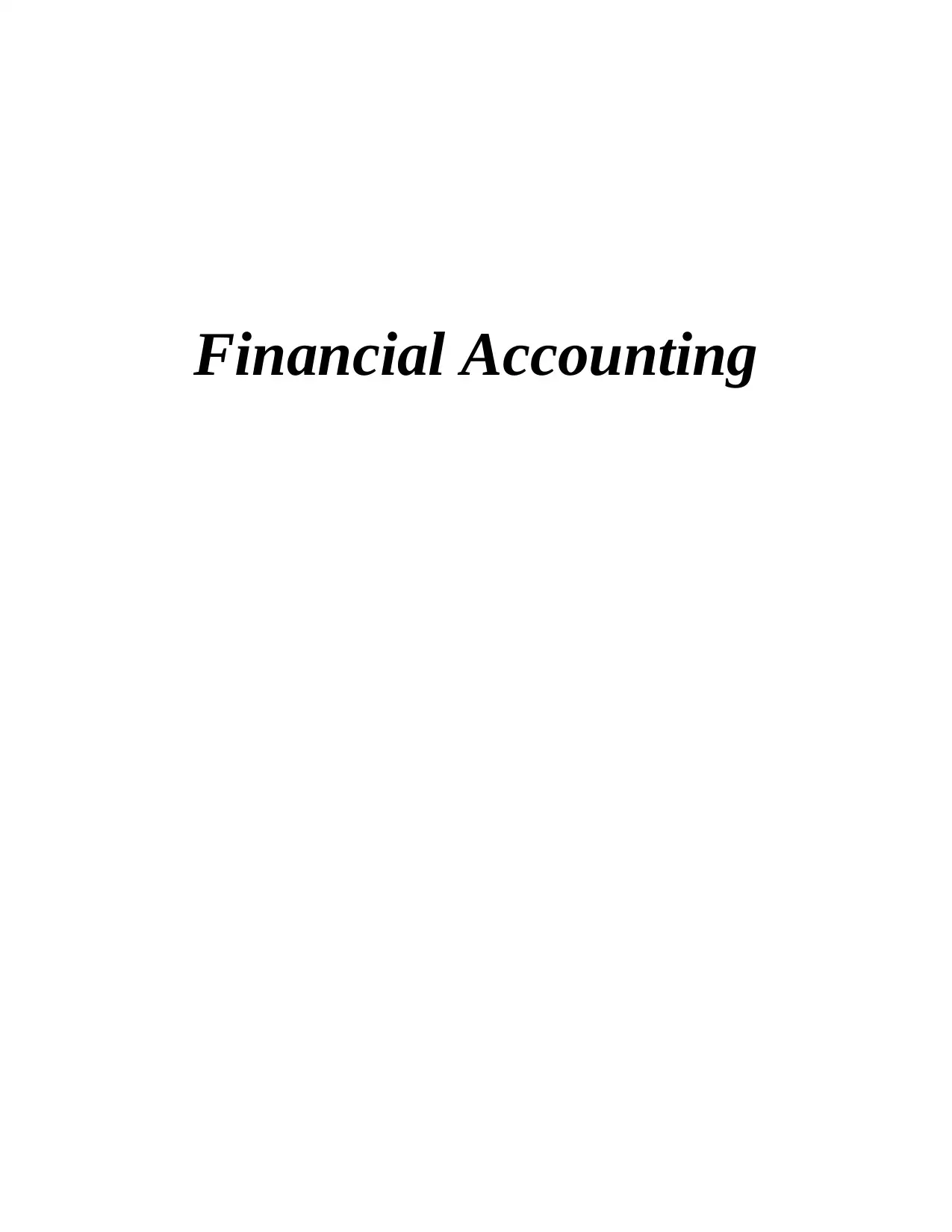
Financial Accounting
Paraphrase This Document
Need a fresh take? Get an instant paraphrase of this document with our AI Paraphraser
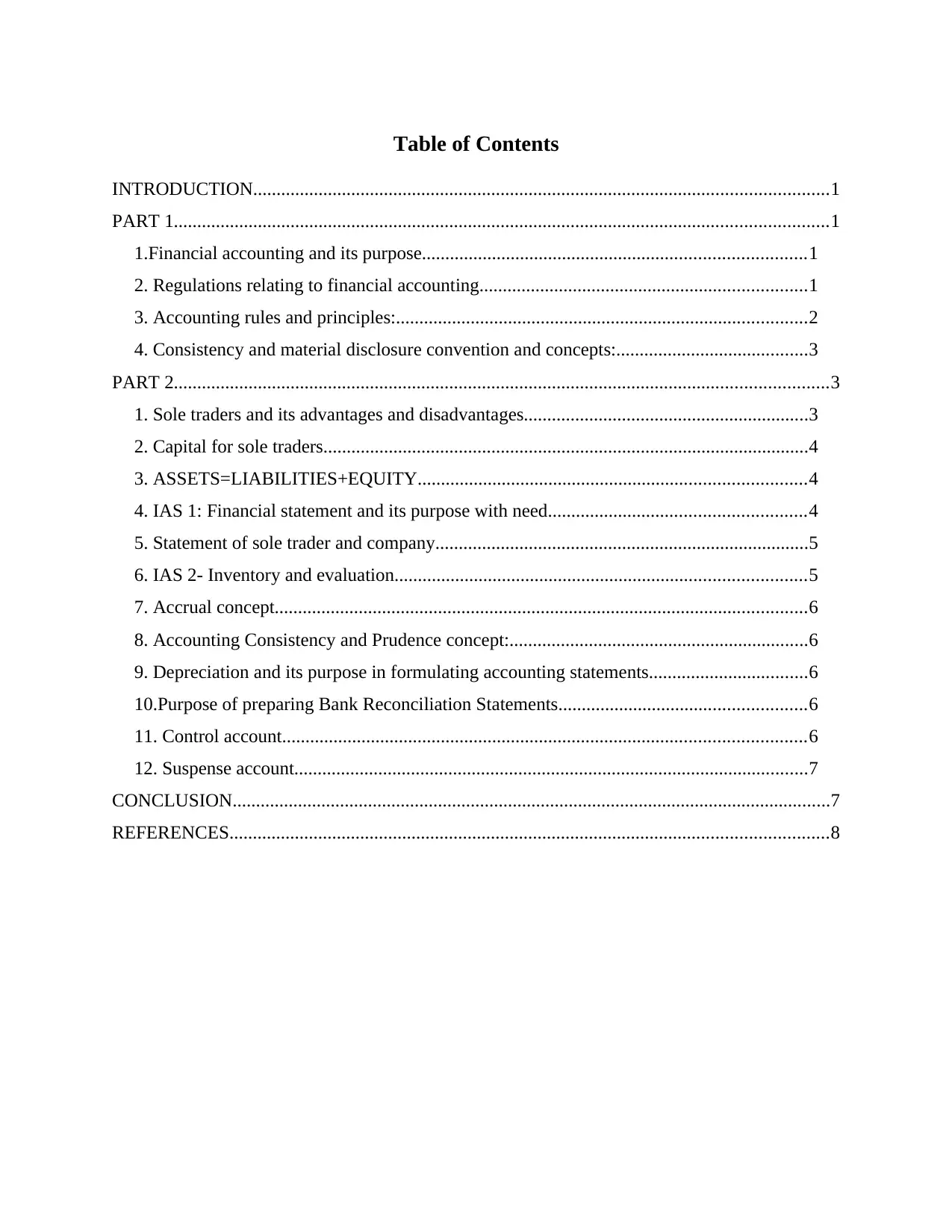
Table of Contents
INTRODUCTION...........................................................................................................................1
PART 1............................................................................................................................................1
1.Financial accounting and its purpose..................................................................................1
2. Regulations relating to financial accounting......................................................................1
3. Accounting rules and principles:........................................................................................2
4. Consistency and material disclosure convention and concepts:.........................................3
PART 2............................................................................................................................................3
1. Sole traders and its advantages and disadvantages.............................................................3
2. Capital for sole traders........................................................................................................4
3. ASSETS=LIABILITIES+EQUITY...................................................................................4
4. IAS 1: Financial statement and its purpose with need.......................................................4
5. Statement of sole trader and company................................................................................5
6. IAS 2- Inventory and evaluation........................................................................................5
7. Accrual concept..................................................................................................................6
8. Accounting Consistency and Prudence concept:................................................................6
9. Depreciation and its purpose in formulating accounting statements..................................6
10.Purpose of preparing Bank Reconciliation Statements.....................................................6
11. Control account................................................................................................................6
12. Suspense account..............................................................................................................7
CONCLUSION................................................................................................................................7
REFERENCES................................................................................................................................8
INTRODUCTION...........................................................................................................................1
PART 1............................................................................................................................................1
1.Financial accounting and its purpose..................................................................................1
2. Regulations relating to financial accounting......................................................................1
3. Accounting rules and principles:........................................................................................2
4. Consistency and material disclosure convention and concepts:.........................................3
PART 2............................................................................................................................................3
1. Sole traders and its advantages and disadvantages.............................................................3
2. Capital for sole traders........................................................................................................4
3. ASSETS=LIABILITIES+EQUITY...................................................................................4
4. IAS 1: Financial statement and its purpose with need.......................................................4
5. Statement of sole trader and company................................................................................5
6. IAS 2- Inventory and evaluation........................................................................................5
7. Accrual concept..................................................................................................................6
8. Accounting Consistency and Prudence concept:................................................................6
9. Depreciation and its purpose in formulating accounting statements..................................6
10.Purpose of preparing Bank Reconciliation Statements.....................................................6
11. Control account................................................................................................................6
12. Suspense account..............................................................................................................7
CONCLUSION................................................................................................................................7
REFERENCES................................................................................................................................8
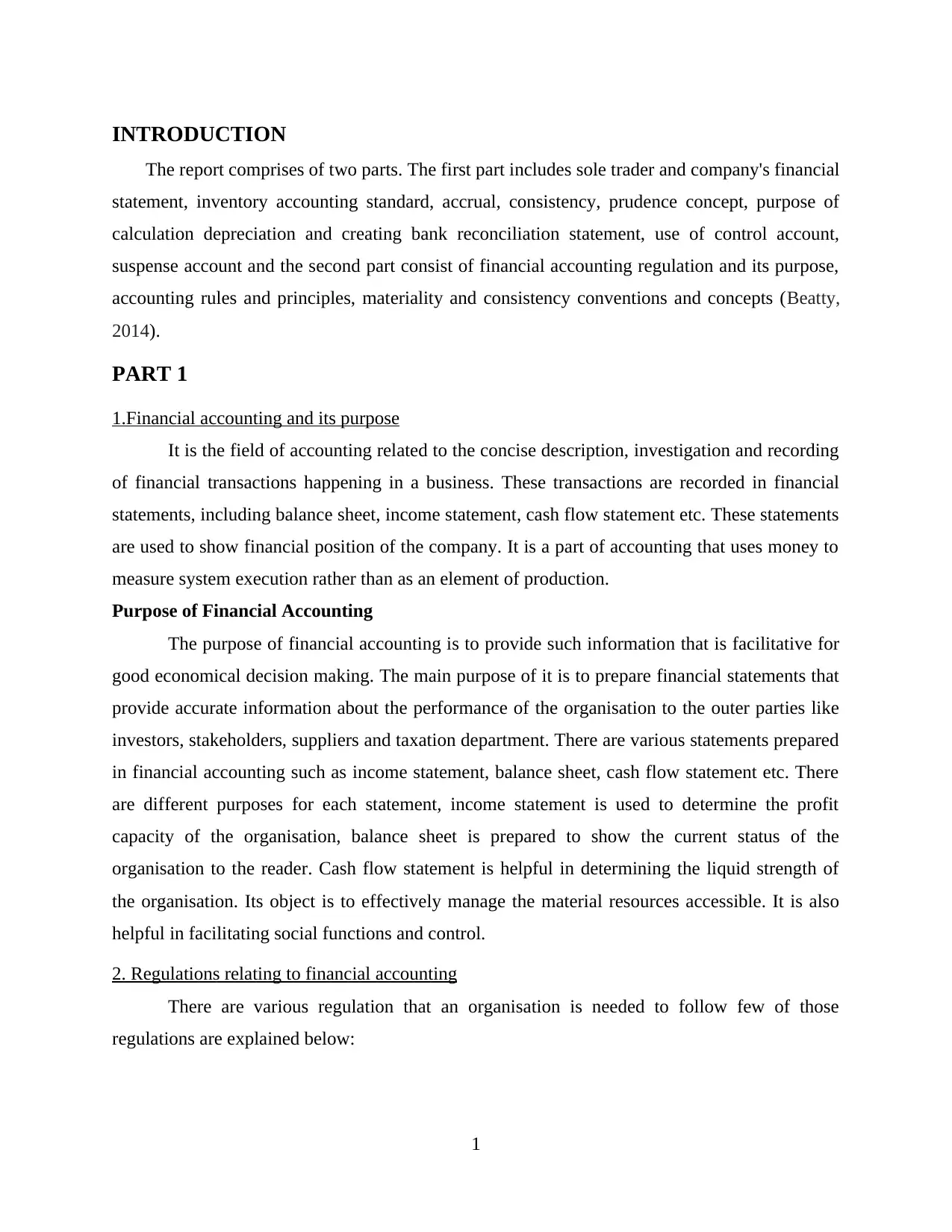
INTRODUCTION
The report comprises of two parts. The first part includes sole trader and company's financial
statement, inventory accounting standard, accrual, consistency, prudence concept, purpose of
calculation depreciation and creating bank reconciliation statement, use of control account,
suspense account and the second part consist of financial accounting regulation and its purpose,
accounting rules and principles, materiality and consistency conventions and concepts (Beatty,
2014).
PART 1
1.Financial accounting and its purpose
It is the field of accounting related to the concise description, investigation and recording
of financial transactions happening in a business. These transactions are recorded in financial
statements, including balance sheet, income statement, cash flow statement etc. These statements
are used to show financial position of the company. It is a part of accounting that uses money to
measure system execution rather than as an element of production.
Purpose of Financial Accounting
The purpose of financial accounting is to provide such information that is facilitative for
good economical decision making. The main purpose of it is to prepare financial statements that
provide accurate information about the performance of the organisation to the outer parties like
investors, stakeholders, suppliers and taxation department. There are various statements prepared
in financial accounting such as income statement, balance sheet, cash flow statement etc. There
are different purposes for each statement, income statement is used to determine the profit
capacity of the organisation, balance sheet is prepared to show the current status of the
organisation to the reader. Cash flow statement is helpful in determining the liquid strength of
the organisation. Its object is to effectively manage the material resources accessible. It is also
helpful in facilitating social functions and control.
2. Regulations relating to financial accounting
There are various regulation that an organisation is needed to follow few of those
regulations are explained below:
1
The report comprises of two parts. The first part includes sole trader and company's financial
statement, inventory accounting standard, accrual, consistency, prudence concept, purpose of
calculation depreciation and creating bank reconciliation statement, use of control account,
suspense account and the second part consist of financial accounting regulation and its purpose,
accounting rules and principles, materiality and consistency conventions and concepts (Beatty,
2014).
PART 1
1.Financial accounting and its purpose
It is the field of accounting related to the concise description, investigation and recording
of financial transactions happening in a business. These transactions are recorded in financial
statements, including balance sheet, income statement, cash flow statement etc. These statements
are used to show financial position of the company. It is a part of accounting that uses money to
measure system execution rather than as an element of production.
Purpose of Financial Accounting
The purpose of financial accounting is to provide such information that is facilitative for
good economical decision making. The main purpose of it is to prepare financial statements that
provide accurate information about the performance of the organisation to the outer parties like
investors, stakeholders, suppliers and taxation department. There are various statements prepared
in financial accounting such as income statement, balance sheet, cash flow statement etc. There
are different purposes for each statement, income statement is used to determine the profit
capacity of the organisation, balance sheet is prepared to show the current status of the
organisation to the reader. Cash flow statement is helpful in determining the liquid strength of
the organisation. Its object is to effectively manage the material resources accessible. It is also
helpful in facilitating social functions and control.
2. Regulations relating to financial accounting
There are various regulation that an organisation is needed to follow few of those
regulations are explained below:
1
⊘ This is a preview!⊘
Do you want full access?
Subscribe today to unlock all pages.

Trusted by 1+ million students worldwide
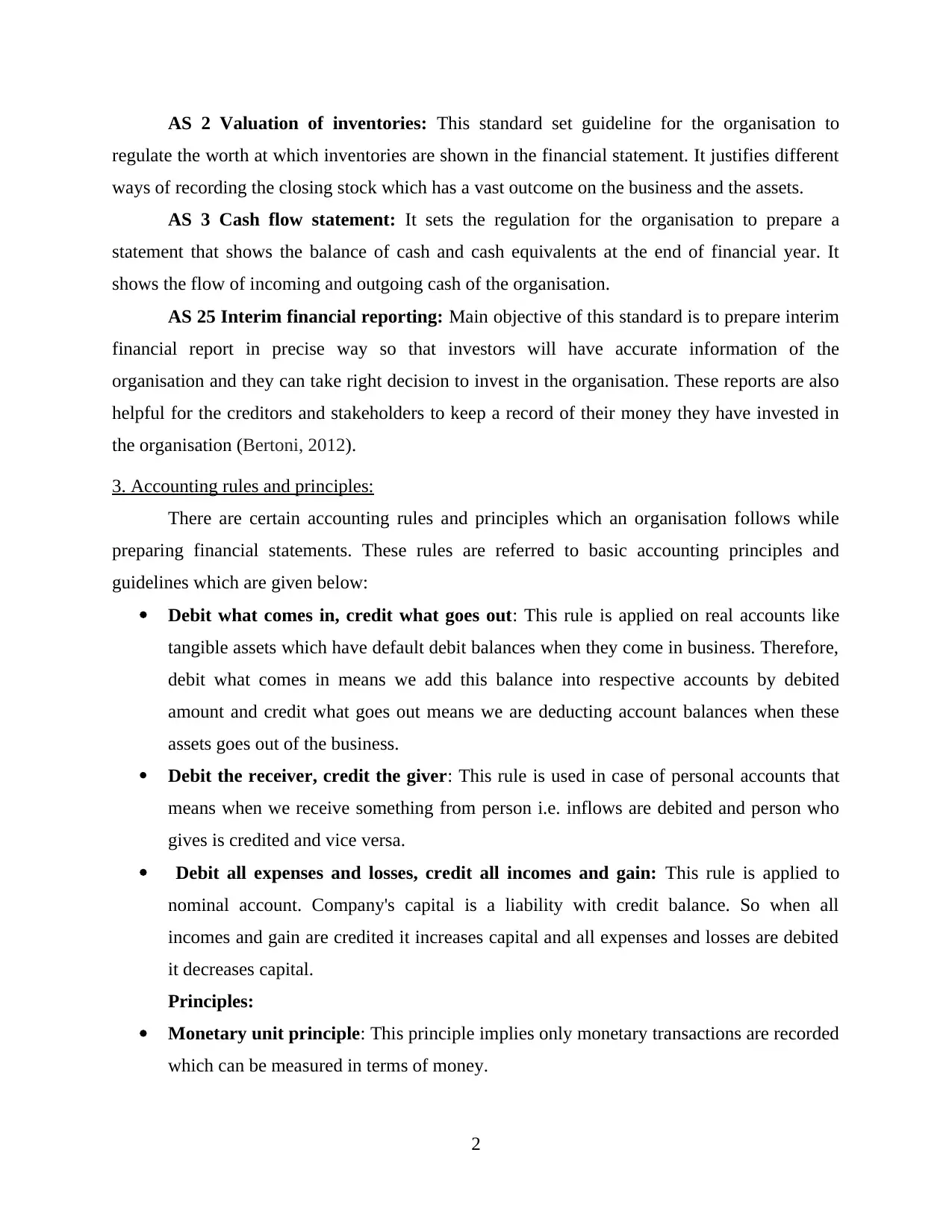
AS 2 Valuation of inventories: This standard set guideline for the organisation to
regulate the worth at which inventories are shown in the financial statement. It justifies different
ways of recording the closing stock which has a vast outcome on the business and the assets.
AS 3 Cash flow statement: It sets the regulation for the organisation to prepare a
statement that shows the balance of cash and cash equivalents at the end of financial year. It
shows the flow of incoming and outgoing cash of the organisation.
AS 25 Interim financial reporting: Main objective of this standard is to prepare interim
financial report in precise way so that investors will have accurate information of the
organisation and they can take right decision to invest in the organisation. These reports are also
helpful for the creditors and stakeholders to keep a record of their money they have invested in
the organisation (Bertoni, 2012).
3. Accounting rules and principles:
There are certain accounting rules and principles which an organisation follows while
preparing financial statements. These rules are referred to basic accounting principles and
guidelines which are given below:
Debit what comes in, credit what goes out: This rule is applied on real accounts like
tangible assets which have default debit balances when they come in business. Therefore,
debit what comes in means we add this balance into respective accounts by debited
amount and credit what goes out means we are deducting account balances when these
assets goes out of the business.
Debit the receiver, credit the giver: This rule is used in case of personal accounts that
means when we receive something from person i.e. inflows are debited and person who
gives is credited and vice versa.
Debit all expenses and losses, credit all incomes and gain: This rule is applied to
nominal account. Company's capital is a liability with credit balance. So when all
incomes and gain are credited it increases capital and all expenses and losses are debited
it decreases capital.
Principles:
Monetary unit principle: This principle implies only monetary transactions are recorded
which can be measured in terms of money.
2
regulate the worth at which inventories are shown in the financial statement. It justifies different
ways of recording the closing stock which has a vast outcome on the business and the assets.
AS 3 Cash flow statement: It sets the regulation for the organisation to prepare a
statement that shows the balance of cash and cash equivalents at the end of financial year. It
shows the flow of incoming and outgoing cash of the organisation.
AS 25 Interim financial reporting: Main objective of this standard is to prepare interim
financial report in precise way so that investors will have accurate information of the
organisation and they can take right decision to invest in the organisation. These reports are also
helpful for the creditors and stakeholders to keep a record of their money they have invested in
the organisation (Bertoni, 2012).
3. Accounting rules and principles:
There are certain accounting rules and principles which an organisation follows while
preparing financial statements. These rules are referred to basic accounting principles and
guidelines which are given below:
Debit what comes in, credit what goes out: This rule is applied on real accounts like
tangible assets which have default debit balances when they come in business. Therefore,
debit what comes in means we add this balance into respective accounts by debited
amount and credit what goes out means we are deducting account balances when these
assets goes out of the business.
Debit the receiver, credit the giver: This rule is used in case of personal accounts that
means when we receive something from person i.e. inflows are debited and person who
gives is credited and vice versa.
Debit all expenses and losses, credit all incomes and gain: This rule is applied to
nominal account. Company's capital is a liability with credit balance. So when all
incomes and gain are credited it increases capital and all expenses and losses are debited
it decreases capital.
Principles:
Monetary unit principle: This principle implies only monetary transactions are recorded
which can be measured in terms of money.
2
Paraphrase This Document
Need a fresh take? Get an instant paraphrase of this document with our AI Paraphraser
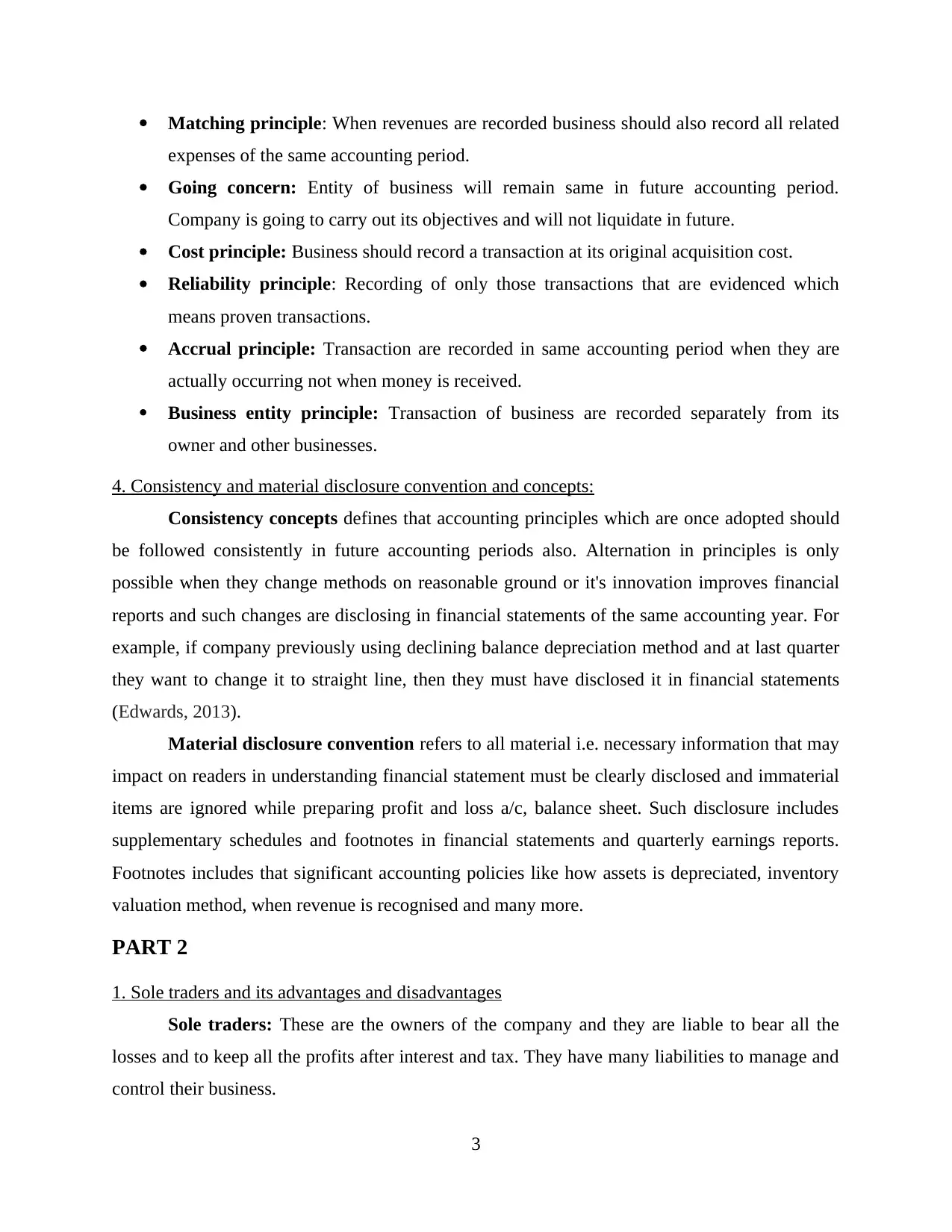
Matching principle: When revenues are recorded business should also record all related
expenses of the same accounting period.
Going concern: Entity of business will remain same in future accounting period.
Company is going to carry out its objectives and will not liquidate in future.
Cost principle: Business should record a transaction at its original acquisition cost.
Reliability principle: Recording of only those transactions that are evidenced which
means proven transactions.
Accrual principle: Transaction are recorded in same accounting period when they are
actually occurring not when money is received.
Business entity principle: Transaction of business are recorded separately from its
owner and other businesses.
4. Consistency and material disclosure convention and concepts:
Consistency concepts defines that accounting principles which are once adopted should
be followed consistently in future accounting periods also. Alternation in principles is only
possible when they change methods on reasonable ground or it's innovation improves financial
reports and such changes are disclosing in financial statements of the same accounting year. For
example, if company previously using declining balance depreciation method and at last quarter
they want to change it to straight line, then they must have disclosed it in financial statements
(Edwards, 2013).
Material disclosure convention refers to all material i.e. necessary information that may
impact on readers in understanding financial statement must be clearly disclosed and immaterial
items are ignored while preparing profit and loss a/c, balance sheet. Such disclosure includes
supplementary schedules and footnotes in financial statements and quarterly earnings reports.
Footnotes includes that significant accounting policies like how assets is depreciated, inventory
valuation method, when revenue is recognised and many more.
PART 2
1. Sole traders and its advantages and disadvantages
Sole traders: These are the owners of the company and they are liable to bear all the
losses and to keep all the profits after interest and tax. They have many liabilities to manage and
control their business.
3
expenses of the same accounting period.
Going concern: Entity of business will remain same in future accounting period.
Company is going to carry out its objectives and will not liquidate in future.
Cost principle: Business should record a transaction at its original acquisition cost.
Reliability principle: Recording of only those transactions that are evidenced which
means proven transactions.
Accrual principle: Transaction are recorded in same accounting period when they are
actually occurring not when money is received.
Business entity principle: Transaction of business are recorded separately from its
owner and other businesses.
4. Consistency and material disclosure convention and concepts:
Consistency concepts defines that accounting principles which are once adopted should
be followed consistently in future accounting periods also. Alternation in principles is only
possible when they change methods on reasonable ground or it's innovation improves financial
reports and such changes are disclosing in financial statements of the same accounting year. For
example, if company previously using declining balance depreciation method and at last quarter
they want to change it to straight line, then they must have disclosed it in financial statements
(Edwards, 2013).
Material disclosure convention refers to all material i.e. necessary information that may
impact on readers in understanding financial statement must be clearly disclosed and immaterial
items are ignored while preparing profit and loss a/c, balance sheet. Such disclosure includes
supplementary schedules and footnotes in financial statements and quarterly earnings reports.
Footnotes includes that significant accounting policies like how assets is depreciated, inventory
valuation method, when revenue is recognised and many more.
PART 2
1. Sole traders and its advantages and disadvantages
Sole traders: These are the owners of the company and they are liable to bear all the
losses and to keep all the profits after interest and tax. They have many liabilities to manage and
control their business.
3
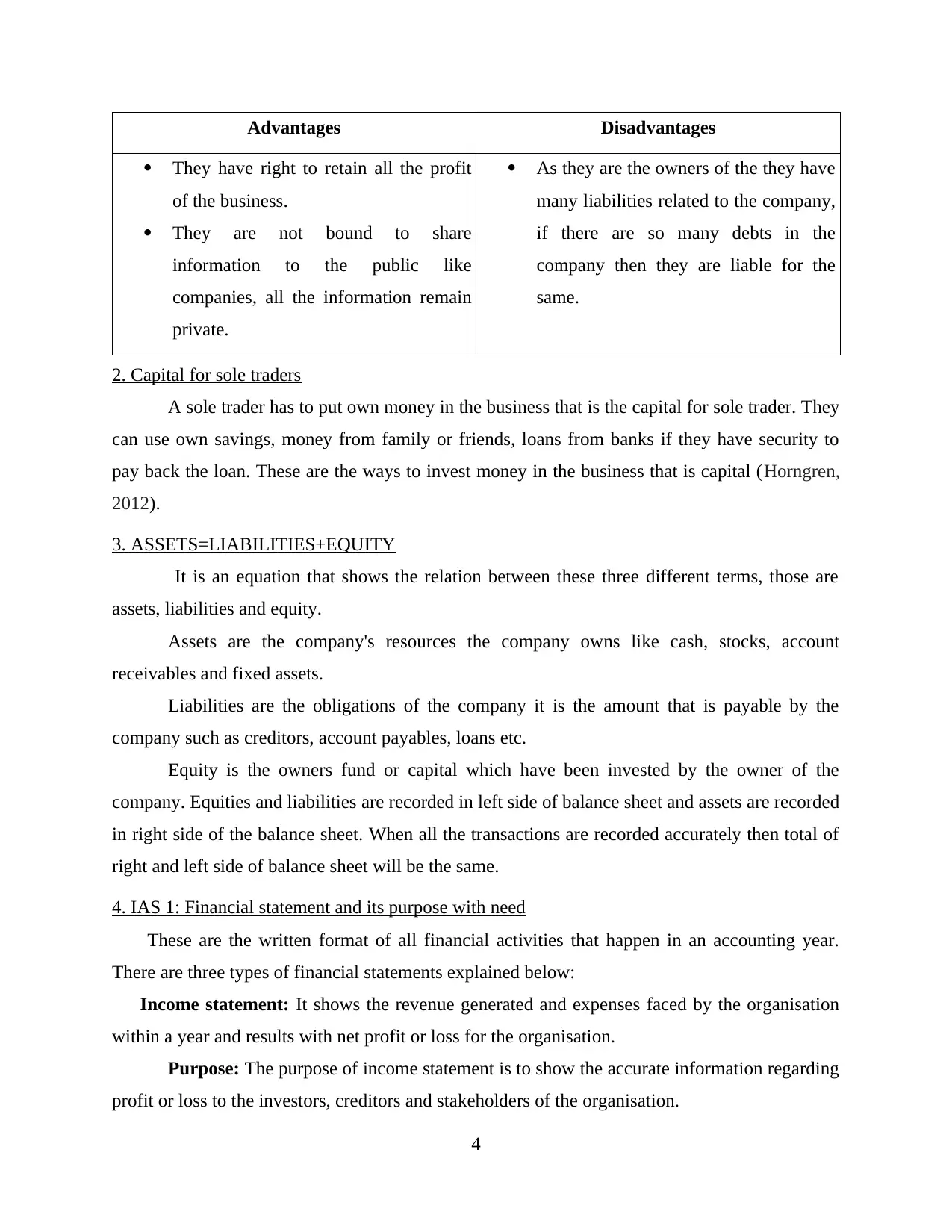
Advantages Disadvantages
They have right to retain all the profit
of the business.
They are not bound to share
information to the public like
companies, all the information remain
private.
As they are the owners of the they have
many liabilities related to the company,
if there are so many debts in the
company then they are liable for the
same.
2. Capital for sole traders
A sole trader has to put own money in the business that is the capital for sole trader. They
can use own savings, money from family or friends, loans from banks if they have security to
pay back the loan. These are the ways to invest money in the business that is capital (Horngren,
2012).
3. ASSETS=LIABILITIES+EQUITY
It is an equation that shows the relation between these three different terms, those are
assets, liabilities and equity.
Assets are the company's resources the company owns like cash, stocks, account
receivables and fixed assets.
Liabilities are the obligations of the company it is the amount that is payable by the
company such as creditors, account payables, loans etc.
Equity is the owners fund or capital which have been invested by the owner of the
company. Equities and liabilities are recorded in left side of balance sheet and assets are recorded
in right side of the balance sheet. When all the transactions are recorded accurately then total of
right and left side of balance sheet will be the same.
4. IAS 1: Financial statement and its purpose with need
These are the written format of all financial activities that happen in an accounting year.
There are three types of financial statements explained below:
Income statement: It shows the revenue generated and expenses faced by the organisation
within a year and results with net profit or loss for the organisation.
Purpose: The purpose of income statement is to show the accurate information regarding
profit or loss to the investors, creditors and stakeholders of the organisation.
4
They have right to retain all the profit
of the business.
They are not bound to share
information to the public like
companies, all the information remain
private.
As they are the owners of the they have
many liabilities related to the company,
if there are so many debts in the
company then they are liable for the
same.
2. Capital for sole traders
A sole trader has to put own money in the business that is the capital for sole trader. They
can use own savings, money from family or friends, loans from banks if they have security to
pay back the loan. These are the ways to invest money in the business that is capital (Horngren,
2012).
3. ASSETS=LIABILITIES+EQUITY
It is an equation that shows the relation between these three different terms, those are
assets, liabilities and equity.
Assets are the company's resources the company owns like cash, stocks, account
receivables and fixed assets.
Liabilities are the obligations of the company it is the amount that is payable by the
company such as creditors, account payables, loans etc.
Equity is the owners fund or capital which have been invested by the owner of the
company. Equities and liabilities are recorded in left side of balance sheet and assets are recorded
in right side of the balance sheet. When all the transactions are recorded accurately then total of
right and left side of balance sheet will be the same.
4. IAS 1: Financial statement and its purpose with need
These are the written format of all financial activities that happen in an accounting year.
There are three types of financial statements explained below:
Income statement: It shows the revenue generated and expenses faced by the organisation
within a year and results with net profit or loss for the organisation.
Purpose: The purpose of income statement is to show the accurate information regarding
profit or loss to the investors, creditors and stakeholders of the organisation.
4
⊘ This is a preview!⊘
Do you want full access?
Subscribe today to unlock all pages.

Trusted by 1+ million students worldwide
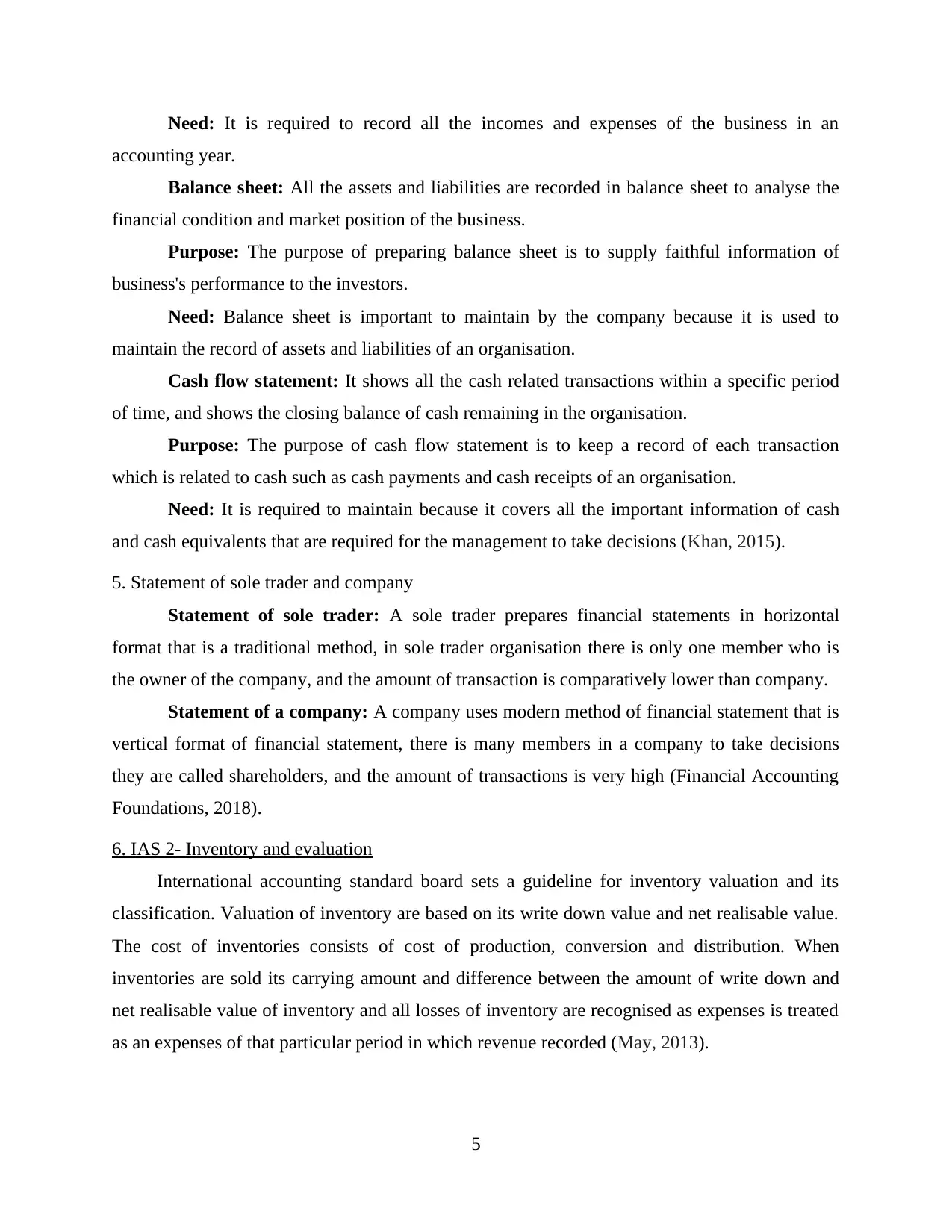
Need: It is required to record all the incomes and expenses of the business in an
accounting year.
Balance sheet: All the assets and liabilities are recorded in balance sheet to analyse the
financial condition and market position of the business.
Purpose: The purpose of preparing balance sheet is to supply faithful information of
business's performance to the investors.
Need: Balance sheet is important to maintain by the company because it is used to
maintain the record of assets and liabilities of an organisation.
Cash flow statement: It shows all the cash related transactions within a specific period
of time, and shows the closing balance of cash remaining in the organisation.
Purpose: The purpose of cash flow statement is to keep a record of each transaction
which is related to cash such as cash payments and cash receipts of an organisation.
Need: It is required to maintain because it covers all the important information of cash
and cash equivalents that are required for the management to take decisions (Khan, 2015).
5. Statement of sole trader and company
Statement of sole trader: A sole trader prepares financial statements in horizontal
format that is a traditional method, in sole trader organisation there is only one member who is
the owner of the company, and the amount of transaction is comparatively lower than company.
Statement of a company: A company uses modern method of financial statement that is
vertical format of financial statement, there is many members in a company to take decisions
they are called shareholders, and the amount of transactions is very high (Financial Accounting
Foundations, 2018).
6. IAS 2- Inventory and evaluation
International accounting standard board sets a guideline for inventory valuation and its
classification. Valuation of inventory are based on its write down value and net realisable value.
The cost of inventories consists of cost of production, conversion and distribution. When
inventories are sold its carrying amount and difference between the amount of write down and
net realisable value of inventory and all losses of inventory are recognised as expenses is treated
as an expenses of that particular period in which revenue recorded (May, 2013).
5
accounting year.
Balance sheet: All the assets and liabilities are recorded in balance sheet to analyse the
financial condition and market position of the business.
Purpose: The purpose of preparing balance sheet is to supply faithful information of
business's performance to the investors.
Need: Balance sheet is important to maintain by the company because it is used to
maintain the record of assets and liabilities of an organisation.
Cash flow statement: It shows all the cash related transactions within a specific period
of time, and shows the closing balance of cash remaining in the organisation.
Purpose: The purpose of cash flow statement is to keep a record of each transaction
which is related to cash such as cash payments and cash receipts of an organisation.
Need: It is required to maintain because it covers all the important information of cash
and cash equivalents that are required for the management to take decisions (Khan, 2015).
5. Statement of sole trader and company
Statement of sole trader: A sole trader prepares financial statements in horizontal
format that is a traditional method, in sole trader organisation there is only one member who is
the owner of the company, and the amount of transaction is comparatively lower than company.
Statement of a company: A company uses modern method of financial statement that is
vertical format of financial statement, there is many members in a company to take decisions
they are called shareholders, and the amount of transactions is very high (Financial Accounting
Foundations, 2018).
6. IAS 2- Inventory and evaluation
International accounting standard board sets a guideline for inventory valuation and its
classification. Valuation of inventory are based on its write down value and net realisable value.
The cost of inventories consists of cost of production, conversion and distribution. When
inventories are sold its carrying amount and difference between the amount of write down and
net realisable value of inventory and all losses of inventory are recognised as expenses is treated
as an expenses of that particular period in which revenue recorded (May, 2013).
5
Paraphrase This Document
Need a fresh take? Get an instant paraphrase of this document with our AI Paraphraser
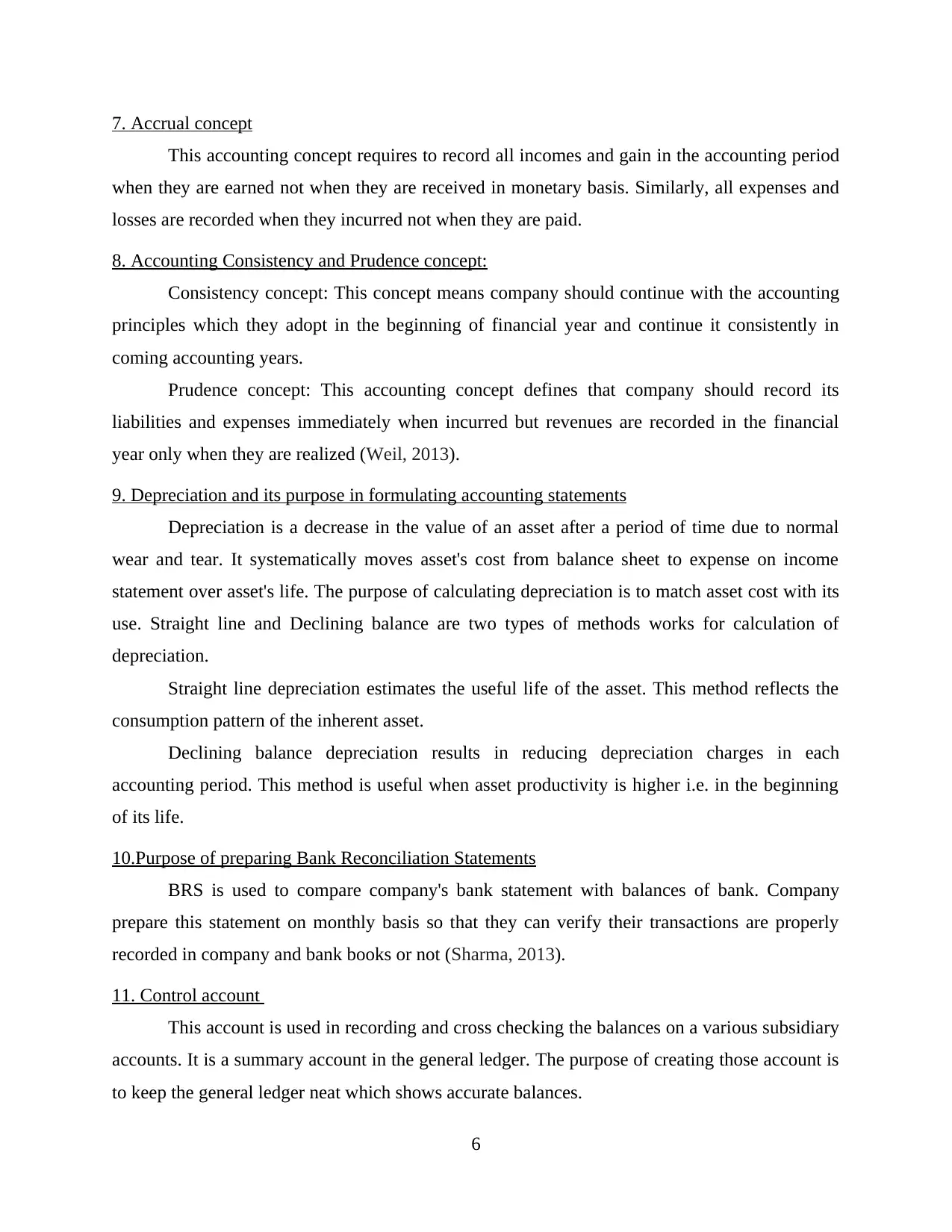
7. Accrual concept
This accounting concept requires to record all incomes and gain in the accounting period
when they are earned not when they are received in monetary basis. Similarly, all expenses and
losses are recorded when they incurred not when they are paid.
8. Accounting Consistency and Prudence concept:
Consistency concept: This concept means company should continue with the accounting
principles which they adopt in the beginning of financial year and continue it consistently in
coming accounting years.
Prudence concept: This accounting concept defines that company should record its
liabilities and expenses immediately when incurred but revenues are recorded in the financial
year only when they are realized (Weil, 2013).
9. Depreciation and its purpose in formulating accounting statements
Depreciation is a decrease in the value of an asset after a period of time due to normal
wear and tear. It systematically moves asset's cost from balance sheet to expense on income
statement over asset's life. The purpose of calculating depreciation is to match asset cost with its
use. Straight line and Declining balance are two types of methods works for calculation of
depreciation.
Straight line depreciation estimates the useful life of the asset. This method reflects the
consumption pattern of the inherent asset.
Declining balance depreciation results in reducing depreciation charges in each
accounting period. This method is useful when asset productivity is higher i.e. in the beginning
of its life.
10.Purpose of preparing Bank Reconciliation Statements
BRS is used to compare company's bank statement with balances of bank. Company
prepare this statement on monthly basis so that they can verify their transactions are properly
recorded in company and bank books or not (Sharma, 2013).
11. Control account
This account is used in recording and cross checking the balances on a various subsidiary
accounts. It is a summary account in the general ledger. The purpose of creating those account is
to keep the general ledger neat which shows accurate balances.
6
This accounting concept requires to record all incomes and gain in the accounting period
when they are earned not when they are received in monetary basis. Similarly, all expenses and
losses are recorded when they incurred not when they are paid.
8. Accounting Consistency and Prudence concept:
Consistency concept: This concept means company should continue with the accounting
principles which they adopt in the beginning of financial year and continue it consistently in
coming accounting years.
Prudence concept: This accounting concept defines that company should record its
liabilities and expenses immediately when incurred but revenues are recorded in the financial
year only when they are realized (Weil, 2013).
9. Depreciation and its purpose in formulating accounting statements
Depreciation is a decrease in the value of an asset after a period of time due to normal
wear and tear. It systematically moves asset's cost from balance sheet to expense on income
statement over asset's life. The purpose of calculating depreciation is to match asset cost with its
use. Straight line and Declining balance are two types of methods works for calculation of
depreciation.
Straight line depreciation estimates the useful life of the asset. This method reflects the
consumption pattern of the inherent asset.
Declining balance depreciation results in reducing depreciation charges in each
accounting period. This method is useful when asset productivity is higher i.e. in the beginning
of its life.
10.Purpose of preparing Bank Reconciliation Statements
BRS is used to compare company's bank statement with balances of bank. Company
prepare this statement on monthly basis so that they can verify their transactions are properly
recorded in company and bank books or not (Sharma, 2013).
11. Control account
This account is used in recording and cross checking the balances on a various subsidiary
accounts. It is a summary account in the general ledger. The purpose of creating those account is
to keep the general ledger neat which shows accurate balances.
6
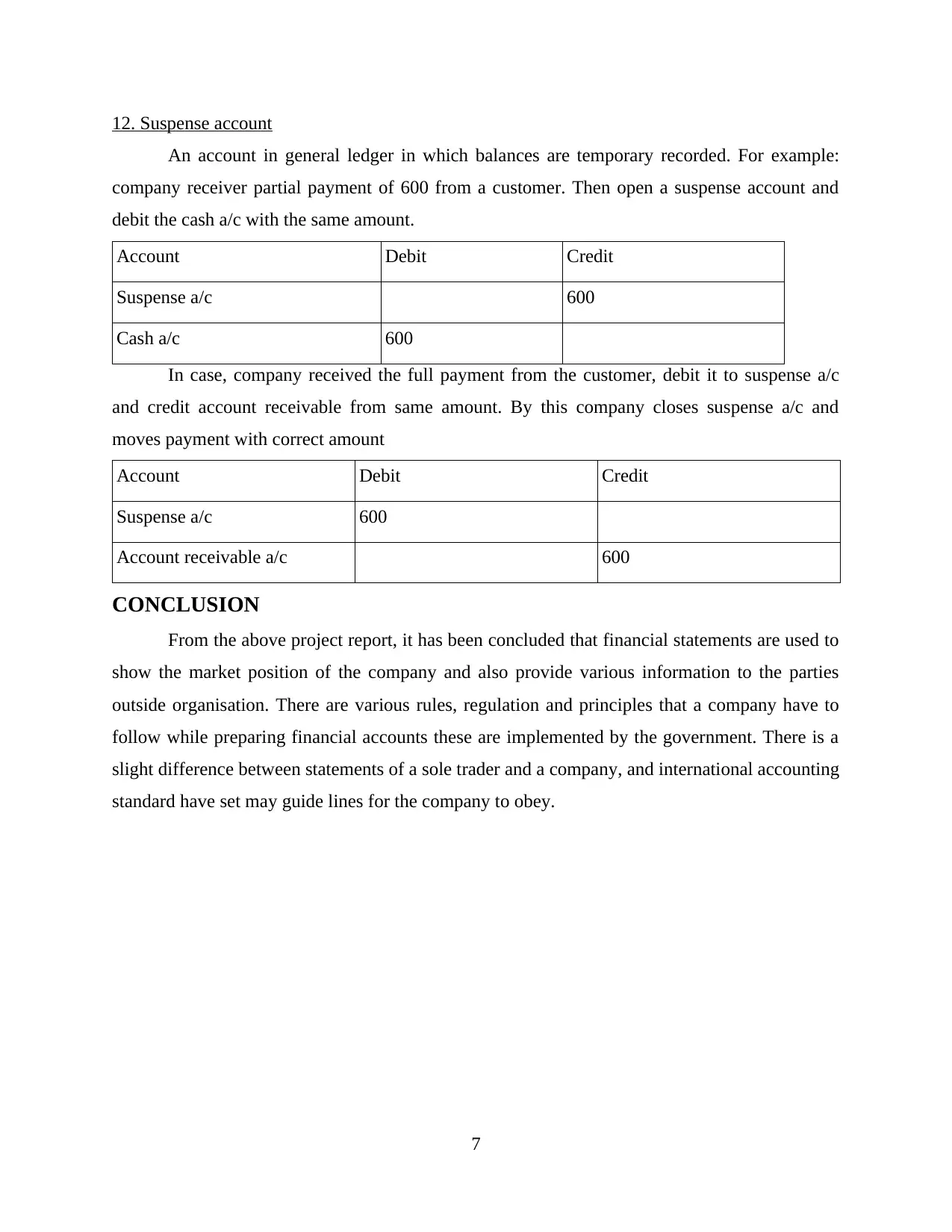
12. Suspense account
An account in general ledger in which balances are temporary recorded. For example:
company receiver partial payment of 600 from a customer. Then open a suspense account and
debit the cash a/c with the same amount.
Account Debit Credit
Suspense a/c 600
Cash a/c 600
In case, company received the full payment from the customer, debit it to suspense a/c
and credit account receivable from same amount. By this company closes suspense a/c and
moves payment with correct amount
Account Debit Credit
Suspense a/c 600
Account receivable a/c 600
CONCLUSION
From the above project report, it has been concluded that financial statements are used to
show the market position of the company and also provide various information to the parties
outside organisation. There are various rules, regulation and principles that a company have to
follow while preparing financial accounts these are implemented by the government. There is a
slight difference between statements of a sole trader and a company, and international accounting
standard have set may guide lines for the company to obey.
7
An account in general ledger in which balances are temporary recorded. For example:
company receiver partial payment of 600 from a customer. Then open a suspense account and
debit the cash a/c with the same amount.
Account Debit Credit
Suspense a/c 600
Cash a/c 600
In case, company received the full payment from the customer, debit it to suspense a/c
and credit account receivable from same amount. By this company closes suspense a/c and
moves payment with correct amount
Account Debit Credit
Suspense a/c 600
Account receivable a/c 600
CONCLUSION
From the above project report, it has been concluded that financial statements are used to
show the market position of the company and also provide various information to the parties
outside organisation. There are various rules, regulation and principles that a company have to
follow while preparing financial accounts these are implemented by the government. There is a
slight difference between statements of a sole trader and a company, and international accounting
standard have set may guide lines for the company to obey.
7
⊘ This is a preview!⊘
Do you want full access?
Subscribe today to unlock all pages.

Trusted by 1+ million students worldwide
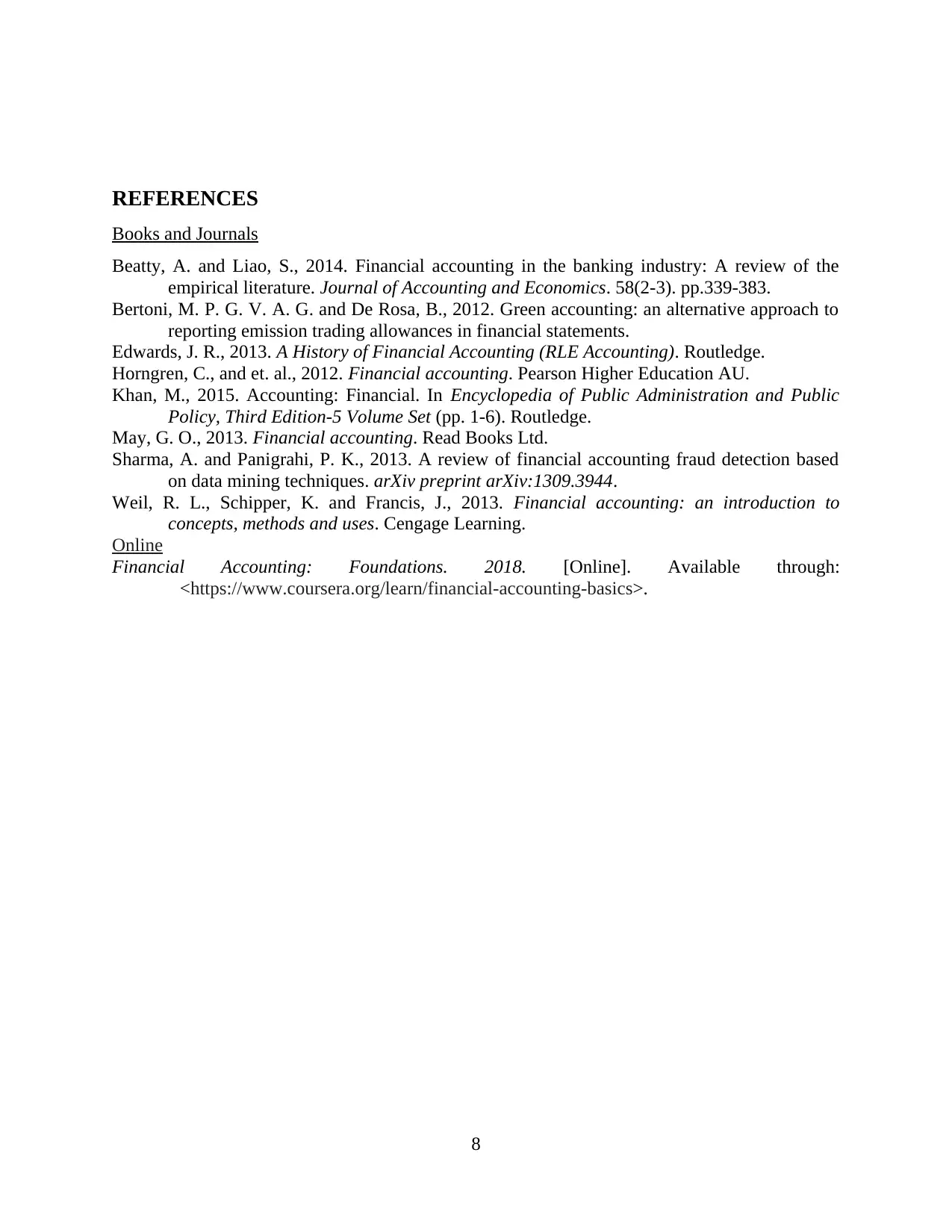
REFERENCES
Books and Journals
Beatty, A. and Liao, S., 2014. Financial accounting in the banking industry: A review of the
empirical literature. Journal of Accounting and Economics. 58(2-3). pp.339-383.
Bertoni, M. P. G. V. A. G. and De Rosa, B., 2012. Green accounting: an alternative approach to
reporting emission trading allowances in financial statements.
Edwards, J. R., 2013. A History of Financial Accounting (RLE Accounting). Routledge.
Horngren, C., and et. al., 2012. Financial accounting. Pearson Higher Education AU.
Khan, M., 2015. Accounting: Financial. In Encyclopedia of Public Administration and Public
Policy, Third Edition-5 Volume Set (pp. 1-6). Routledge.
May, G. O., 2013. Financial accounting. Read Books Ltd.
Sharma, A. and Panigrahi, P. K., 2013. A review of financial accounting fraud detection based
on data mining techniques. arXiv preprint arXiv:1309.3944.
Weil, R. L., Schipper, K. and Francis, J., 2013. Financial accounting: an introduction to
concepts, methods and uses. Cengage Learning.
Online
Financial Accounting: Foundations. 2018. [Online]. Available through:
<https://www.coursera.org/learn/financial-accounting-basics>.
8
Books and Journals
Beatty, A. and Liao, S., 2014. Financial accounting in the banking industry: A review of the
empirical literature. Journal of Accounting and Economics. 58(2-3). pp.339-383.
Bertoni, M. P. G. V. A. G. and De Rosa, B., 2012. Green accounting: an alternative approach to
reporting emission trading allowances in financial statements.
Edwards, J. R., 2013. A History of Financial Accounting (RLE Accounting). Routledge.
Horngren, C., and et. al., 2012. Financial accounting. Pearson Higher Education AU.
Khan, M., 2015. Accounting: Financial. In Encyclopedia of Public Administration and Public
Policy, Third Edition-5 Volume Set (pp. 1-6). Routledge.
May, G. O., 2013. Financial accounting. Read Books Ltd.
Sharma, A. and Panigrahi, P. K., 2013. A review of financial accounting fraud detection based
on data mining techniques. arXiv preprint arXiv:1309.3944.
Weil, R. L., Schipper, K. and Francis, J., 2013. Financial accounting: an introduction to
concepts, methods and uses. Cengage Learning.
Online
Financial Accounting: Foundations. 2018. [Online]. Available through:
<https://www.coursera.org/learn/financial-accounting-basics>.
8
1 out of 10
Related Documents
Your All-in-One AI-Powered Toolkit for Academic Success.
+13062052269
info@desklib.com
Available 24*7 on WhatsApp / Email
![[object Object]](/_next/static/media/star-bottom.7253800d.svg)
Unlock your academic potential
Copyright © 2020–2025 A2Z Services. All Rights Reserved. Developed and managed by ZUCOL.





